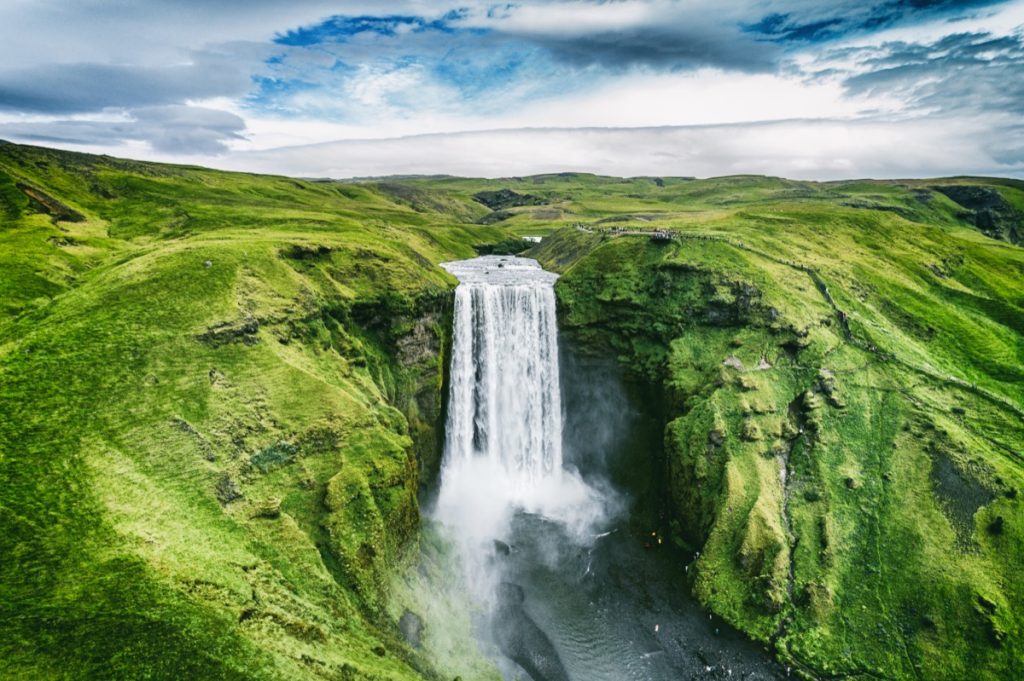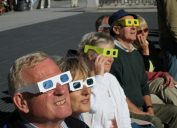5 Places Where You Can See More Solar Eclipses in the Coming Years
You may want to make plans to visit these destinations before the next one.

On April 8, people across North America turned their heads skywards to watch as the moon passed in front of the sun in a total solar eclipse. The relatively uncommon event was the first time such a sight was visible in the U.S. since 2017—and the last one that will be seen stateside until 2044. That means anyone who wants to relive the surreal experience will have to plan to travel to do so. Fortunately, there are some destinations that will be within the path of totality before the end of the decade and are worth visiting in their own right. Read on for the places where you can see more solar eclipses in the coming years.
RELATED: New Star Will "Explode" in the Night Sky—How to See the "Once-in-a-Lifetime" Event.
1
Iceland

Few countries are as sought-after by travelers for their earthly beauty as Iceland—as well as its ability to wow visitors with regular visits from the Northern Lights. The country will also be one of the lucky places where a celestial event will be visible in a few years.
On Aug. 12, 2026, a total solar eclipse will be visible in Iceland, Space.com reports. The path of totality crosses over the country's western coast, including the capital city of Reykjavik, which will see one minute and 46 seconds of full sun coverage. It will also be visible from the famous Reykjanes Peninsula and Snæfellsnes Peninsula for just over two minutes.
Even though the eclipse is taking place later in the day, the sun will still be much higher in the sky relative to other destinations due to its position in the North Atlantic. And while there is the drawback of it being one of the likelier places for cloud cover, one expert says it's still worth the trek.
"For people who have seen a lot of eclipses but never seen Iceland, a 40 percent chance of seeing it is a reasonable risk," Victoria Sahami, owner and founder of Sirius Travel, told Space.com. "It was a no-brainer to put together an eclipse tour to Iceland. It's also where the longest totality is."
RELATED: 25 Solar Eclipse Facts That Will Blow Your Mind.
2
Spain

It's fortunate for a country to have a prime viewing location for a total solar eclipse even once every few decades. But Spain is in the rare position to take in two separate eclipses before 2030.
Like Iceland, the country will see the moon block out the sun on Aug. 12, 2026. The path of totality runs from the northern and northwestern coast and crosses through the central plains. It will then reach the northeastern coastline and outlying islands, including the city of Valencia and the islands of Mallorca and Ibiza, Forbes reports. However, due to how late the eclipse will take place, picking the right viewing place will be everything to ensure you'll actually see it.
"Some parts of Spain have high mountains that can prevent us from seeing the sun during totality, so it is very important to select the location carefully," Oscar Martín Mesonero, an eclipse chaser and astronomer, told Space.com of the 2026 eclipse. "On the east coast, the sun will be only four degrees high, so any building or small mountain could ruin the view—and traffic there will be very bad."
But that's not the only opportunity hopeful viewers have: Less than a year later, on Aug. 2, 2027, the southernmost tip of Spain will be able to view another eclipse. Viewers near Tarifa will be treated to about four minutes and 39 seconds of totality, with the sun much higher in the sky than the previous year's event, per Forbes.
3
North Africa

While it will only graze the southern tip of Europe, the total solar eclipse on Aug. 2, 2027 will be on full display in a handful of countries in North Africa. The path of totality for the event crosses over Morocco, Algeria, Tunisia, Libya, and Egypt, Forbes reports.
Those taking in the spectacle from Luxor, Egypt, can expect a full six minutes and 23 seconds of darkness during the event—the longest it will be anywhere on Earth for the next 87 years, Sky & Telescope reports. There's also almost zero chance of cloud cover at the time of the eclipse.
RELATED: 45 Bizarre Animal Behaviors During a Total Solar Eclipse.
4
Australia

The Southern Hemisphere will also have its chance to catch the moon passing in front of the sun. On July 22, 2028, a total solar eclipse will be visible in Australia.
According to the Astronomical Society of Australia, the path of totality begins in the northeast of the island continent. It then crosses the country towards the southeastern coast, placing Sydney almost at the direct center.
Viewers in the capital city will get roughly three minutes and 45 seconds of darkness. However, experts warn that the chance of cloud cover is greatest in the southeast, and least likely in the north closer to the beginning of the path.
5
New Zealand

Not to be bested by its neighbor, New Zealand will also get to see a total solar eclipse on July 22, 2028. It will be the first the first in the island country since 1965, with a path of totality that crosses over its most southern island. Many are expected to make the trek to make use of the stunning natural landscape as a background for once-in-a-lifetime photos.
"Anyone who is on a line basically going through Queenstown and Alexandra—all those places in Central from Milford to Dunedin will be able to see what those folks in America saw today," Ian Griffin, PhD, astronomer and director of the Otago Museum, told Radio New Zealand on April 8. "Of course, it's the middle of winter, and the sun will be low in the sky, but that makes for some amazing pictures if we do get clear skies, so I'm particularly excited about it."





















